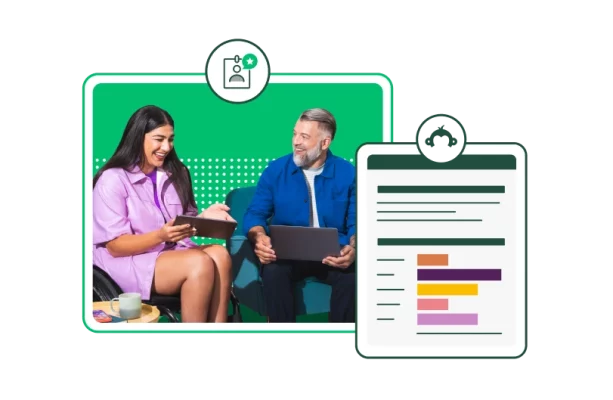How to build an employee engagement program
Learn 5 key steps for building an employee engagement program that boosts job satisfaction and employee motivation. Discover best practices for employee engagement.

HR professionals consistently seek ways to boost employee engagement and job satisfaction. Luckily, there’s a tried-and-true solution: an employee engagement program. Employee engagement programs aim to foster connections to a company, improving productivity strategically.
Why should you create an employee engagement program?
Any employee engagement program aims to improve the employee experience and employee lifecycle. There is a myriad of other reasons to consider dedicating time and resources to building an employee engagement program, including:
Improve employee engagement
You should build an effective employee engagement program to support employees in feeling connected to the company. The deeper the connection employees have with their work, the more pride they take in their contributions to the company's goals.
Employee engagement isn’t just about people showing up to work with smiles. It means employees are genuinely committed to seeing the company succeed. The whole team benefits when employees are enthusiastic about their work and are dedicated to company success.
Increase retention and reduce turnover
HR professionals understand the importance of retention and how much it can affect a company’s bottom line. SHRM reports that the average cost per hire is $4,700 on average. Needing to rehire frequently because of high turnover rates diminishes your bottom line.
An employee engagement program can help you retain employees who may be close to burnout and seeking other career opportunities. Increasing retention of valuable employees keeps operations running smoothly and saves time, money, and effort in the long run.
Boost employee productivity and performance
Employee productivity and performance are imperative to meeting company goals and scaling a business. Productivity is partly driven by an employee’s desire to succeed and directly correlates to employee engagement.
Employees who don’t feel their work matters are less likely to be productive. Addressing engagement levels and improving employees’ feelings toward work can strengthen performance and boost revenue.
Reduce absenteeism
HR teams work toward reducing absenteeism rates and creating healthy work environments. Creating an employee engagement program is one of the best ways to ensure employees don’t take unnecessary sick time and disrupt your company’s workflow. Happy employees with lower stress levels are less likely to call in sick to work.
Improve customer satisfaction
Engaged and satisfied employees are more likely to provide better customer experiences. Employees committed to the company will perform better and drive stronger customer results. This improves productivity and customer service boosts satisfaction and builds loyalty.

5 steps to building a good employee engagement plan
Step 1: Determine focus areas
When implementing employee engagement strategies, you can use employee feedback to help you determine areas for improvement. The best way to learn what would improve the employee experience is to ask employees for their opinions.
Use these feedback channels to gather valuable insights:
Interviews (1:1s)
In employee check-ins (1:1s), managers should ask for candid feedback on improving workplace culture and supporting employee growth and development. Ensure that you’re contributing to a zero-judgment environment where employees feel safe sharing their honest opinions.
Employee feedback surveys
Surveys are among the best ways to collect insight from employees due to their option to remain anonymous. These employee feedback surveys can help highlight employee experience gaps:
- eNPS survey: An employee Net Promoter Score® (eNPS) survey measures employee satisfaction and engagement by determining if an employee is a promoter, detractor, or neutral.
- Employee engagement survey: Employee engagement surveys can help gauge employee motivation and job satisfaction to discern where to improve. With an employee engagement survey, you can glean context for your results by comparing them against SurveyMonkey Employee Engagement Benchmarks.
- Stay interview survey: A stay interview survey provides concrete details about what motivates an employee to attend work every day.
- Employee benefits planning survey: This type of survey focuses on the perks and benefits provided by the company and gathers feedback about which elements need improvements.
- Employee satisfaction survey: An employee satisfaction survey measures team morale and contentment.
Surveys are valuable resources for qualitative and quantitative data that can help your team discover critical areas to address in the engagement program.
Performance reviews
Performance reviews are great opportunities to gather in-depth employee feedback about their feelings toward their work, company culture, benefits and compensation, etc. Managers should engage in open dialogue with employees to gain insight into ideas for improvement, address concerns, and earn recognition.
HR and leadership teams can also send out performance review surveys to collect valuable insight from employees anonymously to improve the number of honest answers. Some employees may feel more comfortable sharing feedback without sharing their identity.
Employee engagement software
Companies can use employee engagement data software to regularly gather quantitative data on employees' engagement, motivation, and involvement. This data can help stakeholders make informed decisions that improve the overall work environment and productivity.
Step 2: Set goals for your employee engagement program
With your focus areas in mind, consider program objectives that reflect your company’s values and mission. Some example targets include:
- Increasing productivity
- Reducing turnover
- Improving employer brand
- Reducing time-to-hire
- Boosting profits
- Increasing employee satisfaction
To track the impact of your employee engagement program, set key performance indicators (KPIs) to target. These metrics may include:
- Turnover rate: Measure the percentage of employees who leave the company within a given time frame (quarterly, annually, etc.).
- Absenteeism rate: Track how many unplanned absences occur within a specific period.
- Retention rate: Determine the percentage of employees that remain employed within a set period.
- Number of employee referrals: Track the number of referrals received for open positions to measure how current employees feel about recommending the company.
- Monthly recurring revenue (MRR): If raising profits is your goal, check the progress in MRR each quarter to measure productivity.
Step 3: Build your action plan
With quality employee data and clear goals in place, you will need to determine an action plan. Your action plan should address all areas of improvement, include clear steps to take, and explain how each action helps achieve better employee engagement.
Each stakeholder (including HR, leadership, and employees) should understand who is responsible for specific initiatives, such as monitoring progress, tracking success metrics, and managing deadlines.
Step 4: Track and analyze results
Tracking and analyzing the results of your employee engagement program is vital to measuring the effectiveness of your efforts. This helps determine if the program improves engagement, retention, and job satisfaction rates.
To track your results, examine whether you are meeting the KPIs you set earlier in the process or are seeing improvement in employee morale and engagement. Look for a reduction in unexpected days off, increased employee referrals, higher productivity levels, and increased revenue.
Analyze these results for recurring themes and trends and communicate these results with employees and other stakeholders.
Step 5: Revisit and revise your program continuously
Revisit your program regularly and gather feedback from employees with pulse surveys. An employee pulse survey can help you understand the impact of your engagement plan and determine the next steps for improvement.
Learn how SurveyMonkey can help you improve employee engagement
Employee engagement programs encourage employees to go the extra mile and give their best effort at work. Boost morale, strengthen company culture, and drive productivity with an employee engagement program.
Learn how Survey Monkey can help you track and understand employee engagement.
Discover more resources

Attract, engage, and retain top talent with data-driven insights
Create powerful HR surveys with SurveyMonkey to gather feedback, boost engagement, and improve workplace culture. Streamline HR processes with customizable templates.

Why are surveys important in research?
Surveys are important in research because they offer a flexible and dependable method of gathering crucial data. Learn more today.

Job application surveys
Survey job applicants online to get a good understanding of your recruitment process strengths and weaknesses. Free templates and survey advice, sign up today!

HR Survey Questions: 80 Examples & Best Practices
Discover 80 HR survey questions, best practices, and tips for success to improve employee engagement.